 |
 Yoneyama Area Yoneyama Area |
 |
 Tsuyama Area Tsuyama Area |
Zennoji Elementary School
Sakuraoka Elementary School
Yoneoka Elementary School
Nakatsuyama Elementary School
Yoneyama Junior High School
Yoneyama Senior High School
Yoneyama Kominkan (community center)
Nakatsuyama Kominkan (community center)
Yoshida Taiikukan (municipal gym)
Yoneyama B & G Ocean Center (gym)
Yoneyama Jukendojo (gym for Judo and Kendo)
Yoshida Undo Koen (sports ground and park)
Nakatsuyama Undojo (municipal sports ground)
|
Yanaizu Elementary School
Ringyo Sogo Center (community center)
Wakamono Sogo Taiikukan (municipal gym)
Tsuyama Municipal Sports Park
Senior Citizens Welfare Center
Tsuyama Junior High School
Tsuyama Kominkan (community center)
Yokoyama Elementary School
|
 Ishikoshi Area Ishikoshi Area |
 |
 Minamikata Area Minamikata Area |
Ishikoshi Elementary School
Ishikoshi Junior High School
Ishikoshi Taiikukan (municipal gym)
Ishikoshi Bosai Center (community center to learn about the prevention of disasters)
Ishikoshi Health Center
Ishikoshi Welfare Center (community center)
Ishikoshi Sogo Undo Koen (sports ground and park)
|
Minamikata Noson Kankyo Kaizen Center (community center)
Minamikata Senior Citizens Welfare Center
Minamikata Sogo Undojo< (sports ground, gym)
Minamikata Elementary School
Minamikata Junior High School
Nishigo Elementary School
Higashigo Elementary School
|
 Nakada Area Nakada Area |
Ishinomori Elementary School
Kagano Elementary School
Takarae Elementary School
Nakada Yochien (kindergarten) (former Niida Elementary School)
Uwanuma Elementary School
Former Uwanuma Elementary School
Nakada Shogai Gakushu Center (community education center) (former Sakuraba Elementary School)
Asamizu Elementary School
Nakada Junior High School
Uwanuma Senior High School
|
 |
Ishinomori Fureai Center (community center)
Takarae Fureai Center (community center)
Uwanuma Fureai Center (community center)
Asamizu Freai Center (community center)
Nakada Sogo Taiikukan (municipal gym)
Nakada B&G Ocean Center (gym)
Nakada Baseball Stadium
Nakada Noson Kankyo Kanzen Center (community center)
Nakada Senior Citizens Welfare Center
|
|
 |
 |
PageTop |
 |
What to do for the disaster prevention:
Earthquakes are frequent in Miyagi .
It is important that citizens should know what to do in case of an earthquake.
| No. 1 |
Top priority is your personal security.
Don't panic. Stay calm.
|
| No. 2 |
Shout to your family members and your neighbors to ensure there are no fires.
Turn off the stove and the gas to the stove to reduce the risk of a fire.
|
| No. 3 |
Find the nearest exit. If you are in a concrete building,
remember to keep doors open and exits open because it is possible for the building to warp, jamming doors or blocking exits.
The first thing you should do is open all the doors and keep the exits clear.
|
| No. 4 |
If a fire breaks out, the first thing you should do is alert your neighbors and the people around you by yelling "Fire."
Then try to put out the fire.
|
| No. 5 |
Get out of the house quickly. Watch out for falling glass and debris. Stay calm.
|
| No. 6 |
Avoid narrow streets, moats, river banks, and cliffs.
Stay away from vending machines, block walls, and gateposts, as they may easily collapse.
|
| No. 7 |
If you live in a step or mountainous area, beware of rock and landslides.
If an earthquake occurs while you are in a mountainous area, take shelter as soon as possible.
|
| No. 8 |
Move to an evacuation site near your house on foot, taking as little with you as possible.
Don't drive as you may get caught in a traffic jam.
It is recommended that you pack emergency kit in advance in a small bag or backpack.
|
| No. 9 |
Communicate with your neighbors and help each other as necessary.
Try to assist people who may be having difficulties, such as the elderly, handicapped, blind, or injured.
|
| No.10 |
Seek information. Be careful of aftershocks. Don't believe gossip or groundless rumors.
|
|
 |
 |
PageTop |
 |
Necessities in the case of disaster
Try to prepare for the disaster
|
Taking out items
The following items are thought to be useful in the case of disaster. Try to be ready to take them out.
|
| Emergency rations Non-cooking foods (canned foods, dried breads, snacks, biscuits) |
| Drinking water |
| Portable radio and dry batteries |
| Flash light, candles |
| Lighter, matches |
| Emergency drug, habitual medicine and sanitary goods |
| Daily necessities. Face towels, tissues, soap, tooth brush, extra towels |
| Blankets, sheets, ropes |
| Clothing, rain coats, umbrellas, cotton work gloves rubber gloves |
| Handkerchiefs, furoshiki (wrapping cloth) |
| Disaster prevention helmets |
| Knives, can opener, bottle opener |
| Plastic bags, plastic sheets, plastic wrap |
| Stationeries (notebooks, pens) |
| Important items (seal, bank account book, health insurance card, drivers license,cash) |
| It is not necessary to take out items greedily. The total weight of the item should be under 10 kg for men and 8kg for women. We suggest you to pack these items into backpacks or into knapsacks. |
| Emergency stocks |
| Foods |
Rice, Instant noodles, Pickled plums, Seasonings, Sweets, Snacks, Vacuum-packed foods |
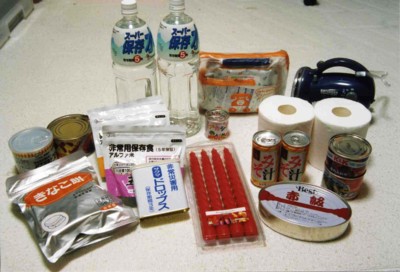 |
| Drinking water (in a plastic bottle) |
About 3 litters of water a day for one person Try to change the bottles for fresh water as often as possible. |
| Solid fuels or a table gas stove, gas cylinder |
Extra gas cylinders are needed. |
| *Stock enough items to support your life for three days, if possible for 5 days, before the restoration from the disaster. Put the packed items in a safety, and an easy place to find. |
| Taking out items Checking List |
| Items related to food, cooking |
- Water (in a plastic bottle or a can)
- Dried bread, snacks, biscuits
- Vacuum-packed food
- Powdered milk, baby bottle
- Pan, canteen
|
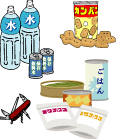 |
|
 |
| Clothing |
- Under wears (for all family members)
- Sleeping bags
- Rain coats, umbrellas
- Towels
- Paper diapers
|
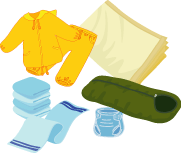 |
|
| Daily Necessities |
- Portable radio
- Flash light
- Extra batteries
- Rope
- Match, lighter
- Kairo (easy warmer)
- Dust-proof mask
- Sanitary goods
- Tissues and wet tissues
- Wrapping paper
- Stationeries
- Thick rubber glove
- Plastic sheet
|
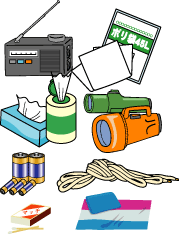 |
|
 |
| Emergency and safety |
- Portable radio
- Emergency drug
- Habitual medicine
- Caps or disaster prevention hood
- Shoes with thick soles
- Cotton work gloves
- Disaster prevention helmets
|
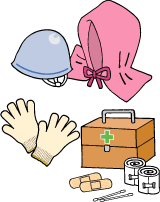 |
|
| Important items |
- Cash (including small coins)
- Bank account book
- Copy of securities
- Inkan (seal)
- Extra pair of glasses
- Health insurance card
- Contact card or any document to prove your identity
|
|
|
|
|
 |
 |
PageTop |
 |
|
In the case of disaster, you can send your messages to your relatives or friends by dialing 117.
It is also possible to listen to the messages from your relatives or from your friends by dialing the same number.
| How to dial 171 |
| 1. |
Pick up the telephone receiver and dial 171.
|
| 2. |
You hear an announcement:
This is the Disaster Message Exclusive Dial Center. Push 1 for recording
message, 2 for listening to messages. If you use your personal identification
number for recording message, push 3, 4 for listening to the messages.
|
| 3. |
After the two steps mentioned above, follow the instructions of the announcement according to each case.
|
Telephone lines may be busy to call specific areas in the case of earthquakes or heavy rain.
This system enables you to contact your relatives, family members and friends living in the disaster areas even when telephone lines are too busy.
NTT EAST Home |
 |
 |
PageTop |
 |
| No.1 |
Monthly family meeting talking about disaster prevention
|
It is important to decide duties of each family member.
- Who is in charge of little children and elderly family members ?
- Who leads family members to the exit ?
- Who will take out emergency items ?
It is necessary to have monthly meeting to check these matters. |
| No.2 |
Reconfirmation of the evacuation sites
|
|
In the case of earthquakes, it may be impossible for every family member to come back home all together.
It is important that every family member should remember which evacuation site is the meeting place for your family.
|
| No.3 |
Reconfirmation of evacuation road, rout to school and the degree of danger.
Try to find safety route where there may be few block walls, roof tiles.
|
|
Signboards and neon signs. Narrow roads or streets are not proper.
|
|
 |
 |
PageTop |
 |
Mechanism of earthquakes
Earthquakes occur because of the movements of the earth's tectonic plates.
Earthquakes are frequent in Japan because the Japanese islands are above two overlapping plates.
The plates moves a few centimeters a year and push against each other, which warps the crust and eventually causes earthquakes.
In July, 1993, there was a big earthquake off the southeast coast of Hokkaido, along the boundary of the plates.
Magnitude and earthquake
Magnitude expresses the scale of earthquakes, and seismic intensity expresses the strength of shaking.
The intensity differs according to the distances from the epicenter of the earthquake.
Generally, even if the magnitude is large, intensity decreases significantly as it moves away from the epicenter.
|
 |
 |
PageTop |
 |
| Fire Station |
->
<- |
Citizen |
| Fire or an Ambulance ? |
|
Fire.(or "Ambulance" in the case of emergency) |
| Is anything burning ? |
|
My house is burning. |
| Tell me your address. |
|
**-machi (or cho),**-banchi, and my name is ***.
*Banchi is a number of your house. |
| Is there anything useful as a landmark near your house ? |
|
My house is in the (north, south, west, east) of ** Elementary School. |
| Is there any one left behind in the house, or anyone injured ? |
|
I am sorry I have no information now. |
| Tell me your name, and your phone number. |
|
My name is Taro Kono. My phone number is **-****. |
| O.K. We will start for your house immediately. |
|
|
| What to do when you dial 119 using your cell phone |
| 1. |
Tell the fire station that you are talking on the cell phone or PHS.
|
| 2. |
Tell your address and a landmark exactly.
|
| 3. |
Fire Station operator may call you to reconfirm your address and your report
|
| 4. |
It is dangerous for you to call a fire station while driving a car.
|
| 5. |
Talk in a loud voice if you call a fire station from your cell phone.
|
| 6. |
When the fire station telephone lines are busy, your phone number will
be displayed automatically on the screen of our communication machine.
Please understand this system.
|
|
  |
|
 |
|
|
 |

